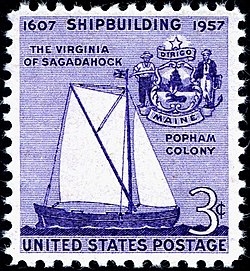Virginia was a pinnace built in 1607 and 1608 by English colonists at the Popham Colony. The ship was a project of the Plymouth Company, branch of the proprietary Virginia Company, on land England claimed as belonging to the Virginia Colony. She was the first English ocean-going vessel built in the New World, and a demonstration of the new colony's ability to build ships. The second and third "local" pinnaces (Deliverance and Patience) were built soon afterwards in Bermuda following the loss of Sea Venture during the Third Supply.
Virginia was built at the mouth of the Kennebec River in what is now Phippsburg, Maine. Little is known about the details of her architecture, but written accounts of the colony and historical records of similar ships suggest that Virginia was a pinnace that displaced about 30 tons and measured somewhat less than 50 ft (15 m) long, with a beam of 14 ft 6 in (4.42 m). She had a flush main deck, drew about 6 ft 6 in (1.98 m) fully loaded, and had a freeboard of less than 2 ft (0.61 m).
